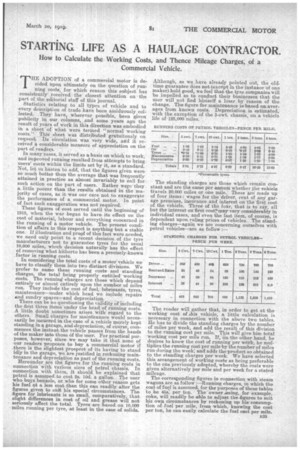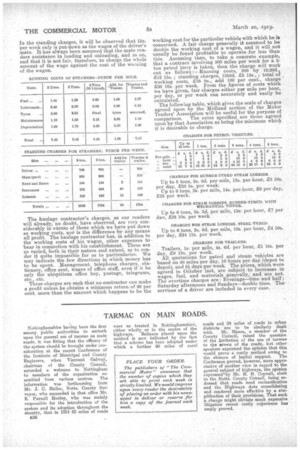STARTiNG. LIFE AS A HAULAGE CONTRACTOR
Page 15

Page 16

If you've noticed an error in this article please click here to report it so we can fix it.
How to Calculate the Working Costs, and Thence Mileage Charges, of a Commercial Vehicle.
THE ADOPTION of a commercial motor is decided upon ultimately on the question of running costs, for which reason this subiect has consistently received the closest attention on the part of the editorial staff of this journal.
Statistics relating to all types of vehicle and to every description of trade have been assiduously collected. They have, wherever possible, been given publicity in our columns, and some years ago the _ .
result of years of work in this direction was embodied in a, sheet of what were United "normal working costs." This sheet was distributed gratuitously on request: Its circulation was very wide, and it received a considerable measure of appreciation on the part of readers. -.
In many cases, it served as a basis on which to work, and improved running resulted from attempts to bring users' costs within the limits set by it, as a standard. Not, let us hasten to add, that the figures given were so much better than the average that was frequently attained in practice as almost invariably to call for such action on the part of users. Rather were-they a little poorer than the results obtained in the majority of eases, as it was our care not to exaggerate the performance of a commercial motor. In point of fact such exaggeration was not required.
These figures of cost served until the beginning of 1915, when the war began to have its effect on the cost of material, labour and everything concerned in the running of a motor vehicle. The present condition of affairs in this respect is anything but a stable one. If illustration and prapf of this fact were needed, we need only point to a recent decision of the tyre manufacturers not to guarantee tyres for the usual 10,000 miles, which decision naturally has the effect of removing what hitherto has been a precisely-known factor in running costs. In considering the total costs of a motor vehicle we have to classify them into two distinct divisions. We prefer to name these running costs and standing charges, the total being properly entitled working costs. The running charges are those which depend entirely or almost entirely upon the number of miles run. They include the cost of fuel, lubritants, -tyres, maintenance—under which head we include repairs and sundry speres—and depreciation. There can be no questioning the validity of including the first three items 'under the head of running costs. A little doubt sometimes arises with regard to the others. Small charges for maintenance would necessarily be incurred in the case of a vehicle merely kept standing in a garage, and depreciation, of course, commences the instant the vehicle passes from the hands of the maker into those of the user. For practical purposes, however, since we may take it that none of our readers proposes to buy a commercial motoe if there is the slightest prospect of its having to stand idly in the garage, we are justified in reckoning maintenance and depreciation as part of the running costs. Hereunder are the figures for the running costs in connection with various sizes of Petrol chassis. In connection with them, it should be explained that petrol is assumed to cost 2s. led. 'a gallon. The user who buys benzole, or who for some other reason gets his fuel at a less ceet than this can readily alter the figures given to suit his special circumstances. The figure for lubricants is so small, comparatively, that slight differences in cost of oil and grease will not seriously affect the total. Tyres are based on 10,000 miles. running per tyre, at least in the ease of solids.
Although, as we have already pointed out, the oldtime guarantee does not (except in the instance of one maker) hold good, we feel that the tyre companies will be impelled so to conduct their businesses that the user will not find himself a loser by reason of the change. The figure for maintenance is.based on-aver-ages from known costs. Depreciation is estimated, with the exception of the 5-cwt. chassis, on a vehicle life of 125,000 miles.
The standing charges are those which remain constant and are the same per annuin whether the vehicle travels 20,000 miles or one mile. These are' made up of four items : wages for the driver, rent of any garage premises, ineerance and interest on-the fitet cost of the Vehicle. Three of. the four; that is to 'say, all but the interest on first cost'-may vary ecmsiderably in individual cases, and even the last item, of couree, is dependent upon ruling' prices of vehicles. The standing charges—again we are concerning ourselves with petrol vehicles—are as follow :—
The reader will gather that, in order to get at the working cost of this vehicle, a little calculation is necessary in connection with the above two tables. He has to divide the standing charges -by the number of miles per week, and add the result of this division to the running cost per mile. This will give him total working cost per mile run. If, on the other hand, he desires to know the cost of running per week, he multiplies the running cost per mile by the number of miles run during the week; and adds the product so obtained to the standing charges per week. We have selected this arrangement of working costs as being preferable to the one previously adopted, whereby the costs were given alternatively per mile and per week for a stated mileage.
The corresponding figures in connection with steam wagons are as follow :—Running charges, in which the cost of fuel is assumed, for the purposes of these tables to be 45s. per ton. The owner ening, for example, coke, will readily be able to adjust the .figures to suit his own circumstances by reckoning up his consumption of fuel per mile, from which, knowing the cost per tonr he can easily calculate the -fuel cost per mile.
In the standing charges, it will be observed that 15s. per week only is putdown as the wages of the driver's mate. It has always been assumed that the mate renders assistance in loading and unloading, and so on, and that it is not fair, therefore, to charge the whole amount of the wage against the cost of the worsing of the wagon.
The haulage contractor's charges, as our readers will already, no doubt, have observed, are very considerably in excess of those which we have put down as working costs, nor is the difference by any means all profit. The haulage contractor has, in addition to the working costs of his wagon, other expenses to • 'bear in connection with his establishment. These are so varied 'both in their nature and extent, as to render it quite impossible for us to particularize. We may indicate the few directions in which money has to be spent. Management, telephone charges, stationery, office rent, wages of office staff, even if it be only the ubiquitous office boy, postage, telegrams, etc., etc.
These charges are such that no contractor can make a profit unless he obtains a minimum return of 60 per cent. more-than the amount which happens to be the working cost for the particular vehicle with which he is concerned. A fair charge generally id assumed to be double the working cost of a wagon and it will not usually be found profitable to operate .for less than this. Assuming then, to take a concrete example, that a contract involving 300 miles per week for a aton petrol lorry is taken, then the charge will -work out as follows :-;--Running costs, 300 by 10.20d., 212 los. ; standing charges, 1356d. 25 13s., • total of working costs, 118 8s., add 100 per cent., charge 236 16s. per week. From the figures of costs which we have given, fair charges either per mile per hour, per day, or per week can accurately and easily be calculated.
The following table, which gives the scale of charges agreed upon by the Midland section of the Motor Traders' Association will be useful for the purpose of comparison. The rates specified are those agreed upon by that Association as being the minimum which it is desirable to charge.
CHARGES FOR RUBBER-TIMED STEAM LORRIES.
Up to 5 tons, 2s. 9d. per mile, 13s. per hour, 25 10s. per day, 230 Ss. per week. Up to 6 tons, 3s. per mile, 14s. per. hour, 26 per day, 233 per week.
CHARGES FOR STEAM LORRIES, RUBBER.TYRED, WITH MECHANICAL TIPPER.
Up to 6 tons, 3s. 3d. per mile, 15s: per hour, 47 per day, 238 lbs. per week.
CHARGES FOR STEAM LORRIES, STEEL TYRED.
Up to 6 tons, 2s. 6d. per mile, 108. per hour, 24 10s. per day, 224 15s. per week.
CHARGES FOR TRAILERS.
Trailers, is. per mile, 4s. 6d. per hour, 21 16s. per day, 29 18s. per week. All quotations for petrol and steam vehicles are based on 40 miles per day, 10 hours per day (depot to depot), and 5i days per week. The prices, which were agreed in October last, are subject to increases in wages, fuel, and materials generally, and are net. The overtime charges are : Evenings-time and half ; Saturday afternoons and Sundays-double time. The services of a driver are included in every case.






















